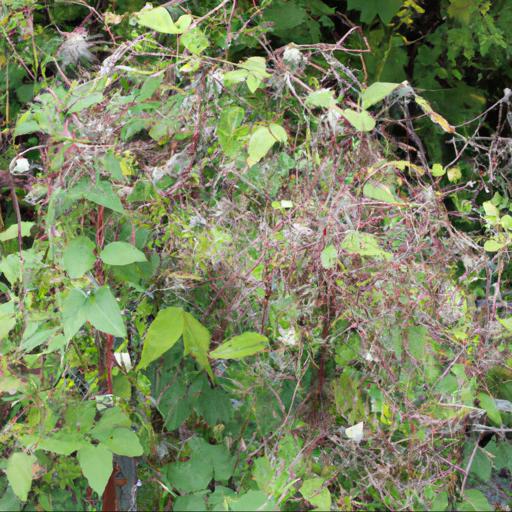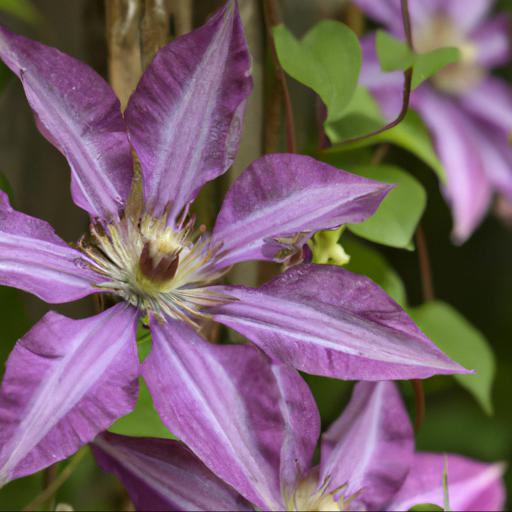Clematis jackmanii is a stunning climbing vine that is native to parts of North America and Europe. With its beautiful purple blooms and lush foliage, it is an ideal choice for adding a touch of elegance to any garden.
Not only is it aesthetically pleasing, but it is also easy to care for and can be grown in most climates. This hardy plant is sure to add a touch of color and life to any outdoor space.
Benefits of growing clematis jackmanii

Gardening is a favorite pastime for many around the world, and for good reason. With a few green fingers and a bit of patience, gardens can become a beautiful haven for any home. Amongst the beautiful vistas, one flower stands out in particular – the Clematis Jackmanii.
This old-fashioned climber is a must-have in any garden. While they can be a little tricky to get just right, their hardy nature and breathtaking flowers make it well worth the effort.
This hardy climber is often left alone, as few people recognize its sensitivity to the sun. The Clematis Jackmanii can be subject to sunburn and signs of heat stress if they don’t have some shade protection, so it is important to give them the right conditions.
Fortunately, they are adaptive and can natively grow in both full and partial shade, making them the perfect choice for any garden. In addition to its ability to thrive in partial shade, the Clematis Jackmanii also offers a spectacular vision when in full bloom. They are perennial flowering climbers and can cover walls, fences, trellises and arches in a flurry of beautiful purple and white blooms.
From March to June, their deep purple flowers will produce a scented paradise for any garden. For gardeners brave enough to try and grow the Clematis Jackmanii, rewards can be great.
Not only will you be surrounded by beautiful flowers in late spring, but the hardy climber does not require any specialist care. With the right conditions, this old-fashioned climber will effortlessly flower each season and put a smile on any gardener’s face.
Tips for planting and caring for clematis jackmanii

:Clematis jackmanii is a truly wonderful climbing plant that adds colour and beauty to any garden. With a little bit of knowledge and proper care, this popular vine can thrive in a variety of climates. Here are some tips for planting and caring for your Clematis jackmanii to ensure a healthy, beautiful plant all season long.
Firstly, the best time to plant your Clematis jackmanii is in early spring, once the ground has thawed and frost danger passes. Plant your Clematis in full sun or partial shade, making sure to provide at least two inches of compost to promote healthy growth.
After planting, be sure to water your clematis well and create a protective barrier of mulch, leaves, or manure around the root system. Next, your Clematis jackmanii will need consistent pruning in order to thrive.
During the first few years, trim excess shoots and stems while they are small and remove all dead flowers after they have bloomed. This helps the plant to focus on growing tall and strong and encourages a healthy root system. After flowering, don’t be afraid to do some late-season pruning to maintain shape and size.
Finally, keep an eye out for any signs of disease or pests, as these are some of the most common problems for Clematis jackmanii. Regularly inspect your plant for signs of damage and promptly remove any affected vines or parts of the plant. Regularly changing the soil, using neem oil or other organic garden sprays, and making sure your Clematis is not overcrowded will go a long way to keeping pests and disease at bay.
When it comes to planting and caring for your Clematis jackmanii, the best advice is: take your time and be patient. With a little effort and attention, your Clematis will thrive and serve as a beautiful addition to your garden.
Common problems with clematis jackmanii

Clematis jackmanii is one of the most popular garden climbing plants in Britain. It is a deciduous perennial that is widely used for ornamental purposes. It blooms with big purple-blue flowers and its attractive foliage makes it even more attractive for gardeners.
Unfortunately, this clematis is prone to some specific problems. One of the most common problems associated with Clematis jackmanii is ‘clematis wilt’.
This is a fungal disease which affects the stems and leaves of the vines, causing infections that block the flow of water and nutrients, leading to wilting and eventual death. The leaves will yellow and then turn brown and die.
Another problem with Clematis jackmanii is its susceptibility to vine weevils. These insects feed on the stems and leaves, damaging the roots as they burrow, resulting in wilted leaves and reduced growth. Given the delicate nature of Clematis jackmanii, even minor damage to the stems and leaves can mean the plant will not survive.
Fortunately, both of these problems can be avoided. With Clematis jackmanii, you need to provide consistent care and maintain its environment in an optimal state.
To prevent clematis wilt, keep the soil moist and add mulch to protect the roots. Additionally, avoid splashing the leaves. To avoid vine weevils, you should apply an insecticide which can be found from local garden supply stores.
With appropriate care, your clematis jackmanii can continue to thrive for many years.
Our video recommendation
Final Touch
The Clematis jackmanii is a popular garden vine that is well known for its beautiful, deep purple flowers. It is easy to grow and requires little maintenance, making it a great choice for those looking to add a bit of color and life to their outdoor space.
It is a fast grower and can reach heights of up to 20 feet, with a spread of up to 8 feet. It also produces an abundance of blooms from late spring to early fall. This hardy vine is a great addition to any garden and will provide years of enjoyment.
FAQ
What is the scientific name of Clematis Jackmanii?
The scientific name of Clematis Jackmanii is Clematis x Jackmanii.
What are the characteristics of Clematis Jackmanii?
The characteristics of Clematis Jackmanii include its large, deep purple flowers, its vigorous growth habit, its ability to tolerate a wide range of temperatures, and its resistance to pests and diseases. It is a deciduous, woody vine that can reach heights of up to 20 feet. It blooms in late spring to early summer and prefers full sun to partial shade.
How can Clematis Jackmanii be propagated?
Clematis Jackmanii can be propagated by taking semi-ripe cuttings in late summer or by layering in late spring.
What is the ideal climate for growing Clematis Jackmanii?
The ideal climate for growing Clematis Jackmanii is one that is cool and moist in the summer, with temperatures between 60-75°F (15-24°C). It should also have plenty of sun and well-draining soil.
What are the common pests and diseases of Clematis Jackmanii?
Common pests and diseases of Clematis Jackmanii include aphids, powdery mildew, clematis wilt, and clematis rust.
How can Clematis Jackmanii be pruned?
Clematis Jackmanii can be pruned by cutting back the stems to a pair of strong buds in late winter or early spring. This will encourage new growth and help to keep the plant healthy and blooming.

